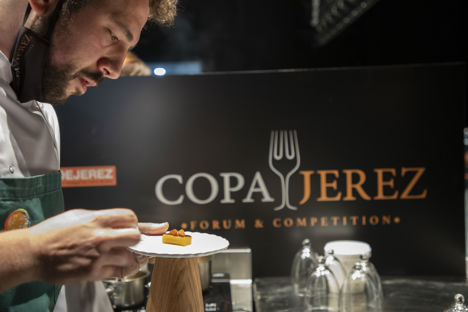
Chefs, sommeliers and sherry: Copa Jerez 2021
Every two years, chefs and sommeliers from around the world team up to create avant-garde dishes that pair perfectly with sherry wines. We took a trip to the Copa Jerez grand final to see just how revolutionary food and sherry matching can be.
Chefs, sommeliers and sherry: Copa Jerez 2021
Every two years, chefs and sommeliers from around the world team up to create avant-garde dishes that pair perfectly with sherry wines. We took a trip to the Copa Jerez grand final to see just how revolutionary food and sherry matching can be.
Being such an iconic Spanish drink means sherry can sometimes be pigeonholed as something to serve exclusively with Spanish food. The truth is, sherry is an incredibly varied, versatile fortified wine that’s suited to all manner of dishes, be they sweet, savoury or from anywhere in the world. Copa Jerez is a worldwide competition which seeks to prove that – and judging by the standards of this year’s entries, it’s certainly achieved its purpose.
The biannual event, which sees chefs and sommeliers team up to create the best inventive three-course menu specifically designed to be paired with different sherries, is now in its ninth year. Finalists from the UK, Belgium, Germany, Denmark, Spain, the US, the Netherlands and Russia descended on Jerez de la Frontera – the home of sherry – to cook and serve their menus for an esteemed panel of judges. This included the UK’s own José Pizarro, along with Josep Roca (the sommelier of the legendary El Celler de Can Roca); Quique Dacosta (from Quique Dacosta Restaurant); Andreas Larsson (World’s Best Sommelier 2007); Peer Holm (president of the German Sommelier Association) and José Carlos Capel (director of Madrid Fusion).
It was a closely fought competition, but it was the Belgium team who clinched the top spot. Chef Fabian Bail and sommelier Paul-Henri Cuvelier from the Paul de Pierre restaurant were awarded first place, along with the awards for Best Chef and Best Sommelier. Their menu showed how the versatile flavours of sherry can work with all manner of flavours.
Their starter – a dish of mackerel with dashi, chorizo, artichoke, pak choi and lovage oil – was paired with Fino Viña Corrales, a fino sherry produced in Jerez itself. The main course of lamb with hazelnut, celeriac and sesame purée, Manchego-stuffed courgette flower and a shiitake and rosemary potato confit came accompanied by an Oloroso from Bodegas Gutierrez Colosía. Finally, for dessert there was a pear in a tobacco spiced syrup with lemon cream and goat’s cheese ice cream, which went perfectly with a sherry called Medium Old Harvest from Bodegas Ximénez-Spinola.
'This pairing had a twofold effect,' said judge Quique Dacosta. 'On the one hand, it basically demonstrated a good, classic knowledge of both food and wine, but there was also a didactic element that reflected an even deeper understanding, leading to a discovery of the pairing and then being carried away by it. That’s where creativity and the imagination come into play, when chef and sommelier work side by side – creating an extraordinary ambience that not only dignifies the dish but also the world of wine.'
There were plenty of other awards to be given out for the best starters, mains, dessert and most creative pairings. The Russian team (sommelier Svetlana Dobrynina of Selfie and chef Mark Statsenko of Straight Fire) took home the creative crown with their unusual dishes, including ‘Forgotten’ orange and onion cooked in salt at 240°, which was paired with a manzanilla. The winners of the UK heat – sommelier Mattia Mazzi and chef Vincenzo Raffone – also impressed with their dishes, which included a rack of lamb with charred artichokes and romesco sauce (paired with a twelve-year-old amontillado).
Sherry is certainly enjoying a renaissance at the moment, with more and more of us realising its food matching potential. Copa Jerez may be an industry-led event, but the competition – along with all the talks, workshops and collaborations which surround it – is at the forefront of pushing the ideas of how sherry can (and should) be served and enjoyed, far beyond the realms of Spanish cuisine.


